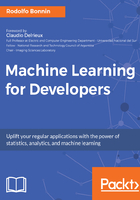
Unsupervised problem solving–clustering
The vast majority of unsupervised problem solving consist of grouping items by looking at similarities or the value of shared features of the observed items, because there is no certain information about the a priori classes. This type of technique is called clustering.
Outside of these main problem types, there is a mix of both, which is called semi-supervised problem solving, in which we can train a labeled set of elements and also use inference to assign information to unlabeled data during training time. To assign data to unknown entities, three main criteria are used—smoothness (points close to each other are of the same class), cluster (data tends to form clusters, a special case of smoothness), and manifold (data pertains to a manifold of much lower dimensionality than the original domain).